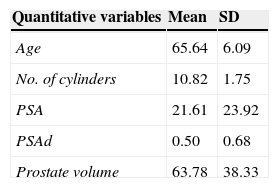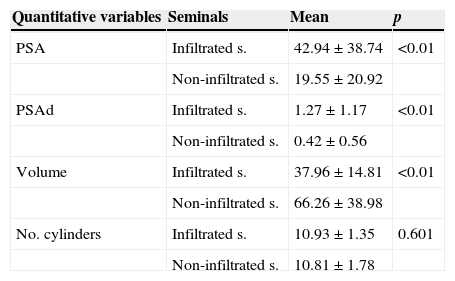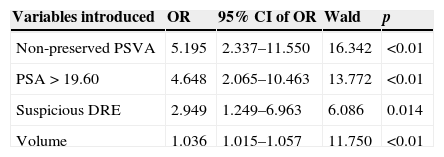The involvement of seminal vesicles in prostate cancer can affect the prognosis and determine the treatment. The objective of this study was to determine whether we could predict its infiltration at the time of the prostate biopsy to know when to indicate the biopsy of the seminal vesicles.
Material and methodsObservational retrospective study of 466 patients who underwent seminal vesicle biopsy. The indication for this biopsy was a prostate-specific antigen (PSA) level greater than 10ng/ml or an asymmetric or obliterated prostatoseminal angle. The following variables were included in the analysis: PSA level, PSA density, prostate volume, number of cores biopsied, suspicious rectal examination, and preservation of the prostatoseminal angle, studying its relationship with the involvement of the seminal vesicles.
ResultsForty-one patients (8.8%) had infiltrated seminal vesicles and 425 (91.2%) had no involvement. In the univariate analysis, the cases with infiltration had a higher mean PSA level (P<.01) and PSA density (P<.01), as well as a lower mean prostate volume (P<.01). A suspicious rectal examination (20.7% of the infiltrated vesicles) and the obliteration or asymmetry of the prostatoseminal angle (33.3% of the infiltrated vesicles) were significantly related to the involvement (P<.01). In the multivariate analysis, we concluded that the probability of having infiltrated seminal vesicles is 5.19 times higher if the prostatoseminal angle is not preserved (P<.01), 4.65 times higher for PSA levels >19.60ng/dL (P<.01) and 2.95 times higher if there is a suspicious rectal examination (P=.014). Furthermore, this probability increases by 1.04 times for each unit of prostate volume lower (P<.01). The ROC curves showed maximum sensitivity and specificity at 19.6ng/mL for PSA and 0.39 for PSA density.
ConclusionsIn this series, greater involvement of seminal vesicles was associated with a PSA level ≥20ng/ml, a suspicious rectal examination and a lack of prostatoseminal angle preservation.
La afectación de las vesículas seminales en el cáncer de próstata puede afectar al pronóstico y condicionar el tratamiento. El objetivo es conocer si podemos predecir su infiltración en el momento de realizar la biopsia prostática para saber cuándo hay que indicar la biopsia de las mismas.
Material y métodosEstudio retrospectivo observacional sobre 466 pacientes a los que se les realizó biopsia de vesículas seminales. La indicación de esta biopsia fue: PSA mayor de 10ng/ml o ángulo prostatoseminal no conservado. En el análisis se incluyeron las siguientes variables: PSA, densidad de PSA, volumen prostático, número de cilindros biopsiados, tacto rectal sospechoso y conservación del ángulo prostatoseminal, estudiándose su relación con la afectación de las vesículas seminales.
ResultadosCuarenta y un sujetos (8,8%) con vesículas seminales infiltradas y 425 (91,2%) libres de afectación. En el análisis univariado los casos con infiltración tenían una media superior en PSA (p<0,01) y densidad de PSA (p<0,01), además de una media de volumen prostático menor (p<0,01). El tacto rectal sospechoso (20,7% de las infiltradas) y la no conservación del ángulo prostatoseminal (33,3% de las infiltradas) se relacionaron de forma significativa con la afectación (p<0,01). En el análisis multivariado se concluye que la probabilidad de tener vesículas seminales infiltradas es 5,19 veces mayor si el ángulo prostatoseminal no está conservado (p<0,01), 4,65 veces mayor si el PSA>19,60ng/dl (p<0,01) y 2,95 veces mayor si existe tacto rectal sospechoso (p=0,014). Asimismo, aumenta en 1,04 veces por unidad de volumen menor (p<0,01). Las curvas ROC mostraron máxima sensibilidad y especificidad en 19,6ng/ml para PSA y 0,39 para densidad de PSA.
ConclusionesEn esta serie se asocian con mayor afectación de vesículas seminales un PSA mayor o igual a 20ng/ml, un tacto rectal sospechoso, o la ausencia de conservación del ángulo prostatoseminal.










